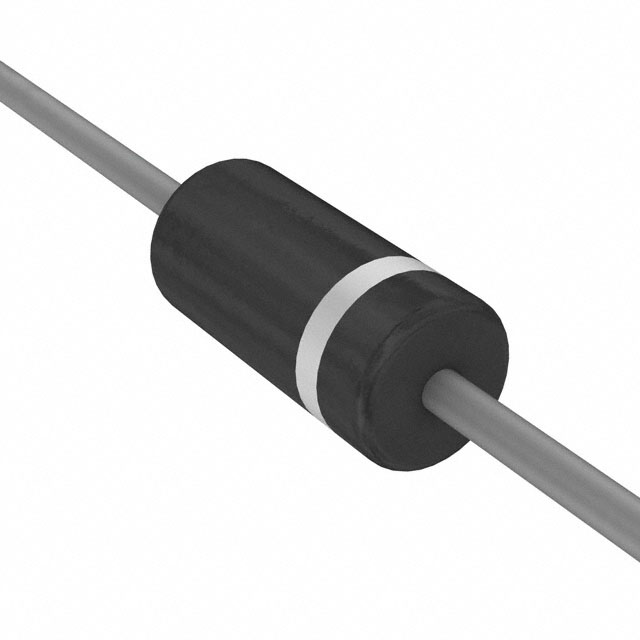Viz Specifikace pro podrobnosti o produktu.

GPP15B-E3/73 Product Overview
Introduction
The GPP15B-E3/73 is a crucial component in the field of electronic devices, offering a wide range of applications and features. This entry will provide an in-depth overview of the product, including its category, use, characteristics, package, essence, packaging/quantity, specifications, detailed pin configuration, functional features, advantages and disadvantages, working principles, detailed application field plans, and alternative models.
Basic Information Overview
- Category: Electronic Component
- Use: Rectifier Diode
- Characteristics: High efficiency, fast switching, low forward voltage drop
- Package: SOD-123FL
- Essence: Silicon Rectifier Diode
- Packaging/Quantity: Tape & Reel, 3000 units per reel
Specifications
- Voltage Rating: 150V
- Forward Current: 1.5A
- Reverse Recovery Time: 35ns
- Operating Temperature Range: -65°C to +175°C
Detailed Pin Configuration
The GPP15B-E3/73 has a standard SOD-123FL package with two pins. Pin 1 is the cathode (K) and pin 2 is the anode (A).
Functional Features
- Fast Switching Speed
- Low Forward Voltage Drop
- High Efficiency
- Low Reverse Leakage Current
Advantages and Disadvantages
Advantages
- High efficiency leads to energy savings
- Fast switching speed improves overall performance
- Low forward voltage drop reduces power loss
Disadvantages
- Limited reverse voltage rating compared to some alternatives
- Sensitive to temperature variations
Working Principles
The GPP15B-E3/73 operates based on the principle of rectification, allowing current to flow in only one direction. When a positive voltage is applied to the anode, it conducts current, while blocking the flow of current when a negative voltage is applied.
Detailed Application Field Plans
The GPP15B-E3/73 is widely used in various electronic circuits and systems, including: - Power Supplies - LED Lighting - Battery Chargers - DC-DC Converters - Automotive Electronics
Detailed and Complete Alternative Models
- Alternative Model 1: GPP20B-E3/73
- Voltage Rating: 200V
- Forward Current: 2A
- Package: SOD-123FL
- Alternative Model 2: GPP10B-E3/73
- Voltage Rating: 100V
- Forward Current: 1A
- Package: SOD-123FL
- Alternative Model 3: GPP15A-E3/73
- Voltage Rating: 150V
- Forward Current: 1.5A
- Package: SOD-123FL
In conclusion, the GPP15B-E3/73 rectifier diode offers high efficiency, fast switching, and low forward voltage drop, making it a versatile component for various electronic applications. Its specifications, functional features, advantages, and detailed application field plans demonstrate its significance in the electronics industry. Additionally, alternative models provide flexibility for different voltage and current requirements.
Seznam 10 běžných otázek a odpovědí souvisejících s aplikací GPP15B-E3/73 v technických řešeních
Sure, here are 10 common questions and answers related to the application of GPP15B-E3/73 in technical solutions:
What is the maximum forward voltage of GPP15B-E3/73?
- The maximum forward voltage of GPP15B-E3/73 is typically 0.55V at 15A.
What is the reverse recovery time of GPP15B-E3/73?
- The reverse recovery time of GPP15B-E3/73 is typically 35ns.
What is the maximum average rectified current for GPP15B-E3/73?
- The maximum average rectified current for GPP15B-E3/73 is 15A.
What is the maximum repetitive peak reverse voltage for GPP15B-E3/73?
- The maximum repetitive peak reverse voltage for GPP15B-E3/73 is 200V.
What is the operating junction temperature range for GPP15B-E3/73?
- The operating junction temperature range for GPP15B-E3/73 is -65°C to +175°C.
Can GPP15B-E3/73 be used in high-frequency applications?
- Yes, GPP15B-E3/73 can be used in high-frequency applications due to its fast recovery time.
Is GPP15B-E3/73 suitable for use in switching power supplies?
- Yes, GPP15B-E3/73 is suitable for use in switching power supplies and other power conversion applications.
What is the package type of GPP15B-E3/73?
- GPP15B-E3/73 comes in a TO-220AB package.
Does GPP15B-E3/73 have a low leakage current?
- Yes, GPP15B-E3/73 has a low leakage current, making it suitable for energy-efficient designs.
Can GPP15B-E3/73 be used in automotive electronics applications?
- Yes, GPP15B-E3/73 is suitable for use in automotive electronics applications due to its rugged construction and reliability.
I hope these answers provide the information you were looking for! If you have any more questions, feel free to ask.

